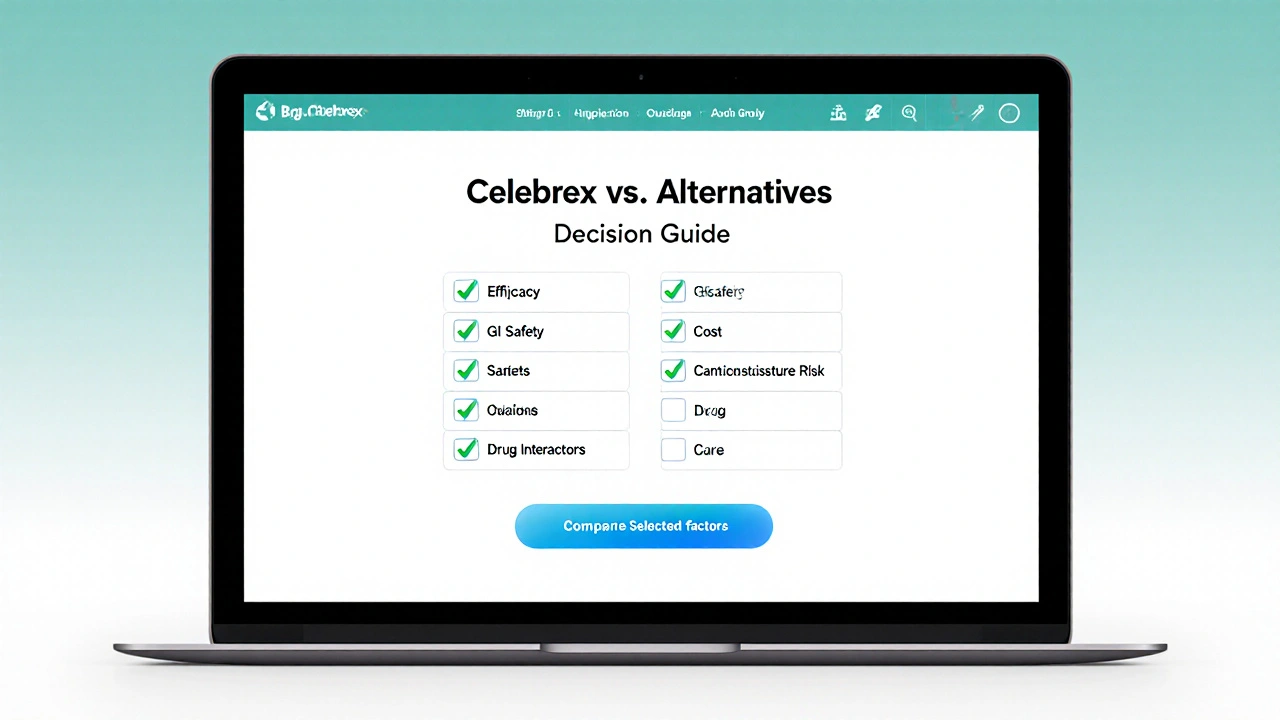Celebrex vs. Alternatives: Decision Guide
Select your key health priorities to find the best NSAID alternative for your needs.
TL;DR
- Celebrex offers targeted COX‑2 inhibition, lower stomach risk but higher heart‑risk.
- Ibuprofen is cheap, widely available, but can irritate the gut with long‑term use.
- Naproxen provides longer pain control, modest heart safety, but may cause fluid retention.
- Meloxicam sits between traditional NSAIDs and COX‑2 blockers, good for chronic arthritis.
- Etoricoxib is a newer COX‑2 drug, similar efficacy to Celebrex, higher cost, limited Australian availability.
What is Celebrex?
When building a pain‑management plan, Celebrex is a prescription‑only non‑steroidal anti‑inflammatory drug (NSAID) that selectively blocks the cyclo‑oxygenase‑2 (COX‑2) enzyme. By sparing COX‑1, it reduces the chance of stomach ulcers that classic NSAIDs often cause. Celebrex was approved by the FDA in 1999 and has become a go‑to for osteoarthritis, rheumatoid arthritis, and acute pain where gastrointestinal safety matters.
How Celebrex Works and Who Benefits Most
COX‑2 is the enzyme that ramps up during inflammation, producing prostaglandins that cause pain and swelling. Celecoxib binds to COX‑2, shutting down that pathway while leaving COX‑1 mostly untouched. The result is effective pain relief with fewer gastric side effects, making it attractive for older adults or patients on blood thinners.
However, COX‑2 inhibition can also affect the balance of clotting factors, which translates into a modest increase in cardiovascular events, especially at high doses or in patients with existing heart disease.
Key Criteria to Compare When Picking an Alternative
Before swapping drugs, think about these five dimensions. Each one can tip the scales depending on your health profile.
- Efficacy for your condition - Does the drug control pain and inflammation enough for arthritis, back pain, or post‑operative discomfort?
- Gastro‑intestinal safety - Are you prone to ulcers, or do you take aspirin/anticoagulants?
- Cardiovascular risk - Do you have hypertension, high cholesterol, or a history of heart attack?
- Cost and insurance coverage - What will you actually pay out‑of‑pocket in Australia?
- Drug interactions - Are you on other meds like SSRIs, diuretics, or steroids?
Side‑by‑Side Look at Popular Alternatives
Below is a quick snapshot of the most common NSAIDs you’ll encounter. All data are based on Australian pricing (2025) and typical dosing guidelines from the Therapeutic Goods Administration (TGA).
| Drug | Class | Typical Dose (once‑daily) | Avg Cost (AU$ per month) | Common Side Effects | Key Advantage |
|---|---|---|---|---|---|
| Celebrex | COX‑2 selective NSAID | 200mg | $45‑$55 | Headache, mild GI upset | Lower ulcer risk |
| Ibuprofen | Non‑selective NSAID | 400‑800mg | $10‑$15 | Stomach irritation, kidney strain | Very cheap, OTC |
| Naproxen | Non‑selective NSAID | 500mg | $12‑$18 | Dizziness, GI upset | Long‑lasting relief (12‑hr) |
| Meloxicam | Preferential COX‑2 NSAID | 7.5mg | $30‑$40 | Rash, mild GI issues | Weekly dosing possible |
| Etoricoxib | COX‑2 selective NSAID | 60mg | $70‑$80 | Hypertension, edema | Strong anti‑inflammatory effect |
| Diclofenac | Non‑selective NSAID | 50mg | $20‑$25 | Liver enzyme rise, GI upset | Effective for acute musculoskeletal pain |

Deep Dive: When Each Alternative Shines
Ibuprofen - Best for short‑term flare‑ups, like a migraine or minor sports injury. Its low price and OTC status make it a household staple. If you have a healthy stomach and no heart disease, ibuprofen is a solid first line.
Naproxen - Ideal for chronic conditions that need steady coverage, such as osteoarthritis. The 12‑hour dosing means fewer pills, which improves adherence. It carries a slightly better cardiovascular profile than other non‑selective NSAIDs, but still warrants caution in patients with hypertension.
Meloxicam - A middle ground between classic NSAIDs and COX‑2 drugs. Its once‑daily dose reduces pill burden, and the modest COX‑2 selectivity gives a gentler stomach impact. Many rheumatologists prescribe it for long‑term arthritis management when cost is a concern.
Etoricoxib - The newest COX‑2 blocker on the Australian market. It rivals Celebrex in pain control and even outperforms it in some inflammatory arthritis trials. The downside is price and the fact that it’s not covered under the Pharmaceutical Benefits Scheme (PBS) for many indications.
Diclofenac - Works quickly and is often chosen for post‑operative pain or acute injuries. Topical gels (e.g., Voltaren) avoid systemic side effects, but oral diclofenac still carries GI and liver warnings.
How to Pick the Right One for You
Use this simple decision flow:
- Do you need long‑term arthritis control? → Consider Celebrex, Meloxicam, or Naproxen.
- Is stomach protection your top priority? → Favor Celebrex or Etoricoxib.
- Do you have a history of heart disease? → Lean toward Naproxen (lowest CV risk) or low‑dose ibuprofen with doctor supervision.
- Is cost the biggest barrier? → Choose ibuprofen or naproxen, both widely subsidised.
- Do you need rapid, short‑term relief? → Ibuprofen, diclofenac (oral or gel) work fast.
Always discuss the choice with your GP or pharmacist, especially if you’re on blood thinners, SSRIs, or have kidney issues.
Practical Checklist Before Switching
- Confirm your diagnosis (arthritis, back pain, post‑surgical).
- List current meds - watch for interactions with anticoagulants, ACE inhibitors, or diuretics.
- Check your latest blood work for kidney and liver function.
- Consider insurance coverage - PBS listing, private health fund.
- Set a trial period (usually 2‑4 weeks) and note pain scores.
- Schedule a follow‑up to review side effects and efficacy.
Potential Pitfalls and How to Avoid Them
Over‑dosing - Never exceed the maximum daily dose without medical advice. For Celebrex, the ceiling is 400mg/day; many patients mistakenly take 600mg hoping for faster relief.
Mixing with alcohol - Even COX‑2 selective drugs can increase bleeding risk when combined with alcohol or antiplatelet agents.
Ignoring warning signs - New pain, swelling, or shortness of breath could signal a heart event. Seek care immediately.
Frequently Asked Questions
Can I take Celebrex with aspirin?
Generally, combining a COX‑2 inhibitor with aspirin isn’t recommended because aspirin blocks COX‑1, negating the stomach‑protective benefit of Celebrex. If you need low‑dose aspirin for heart health, talk to your doctor about the safest NSAID option.
Is ibuprofen safer for my ulcer history?
No. Ibuprofen is a non‑selective NSAID and can aggravate existing ulcers. A COX‑2 selective drug like Celebrex, or a prescription‑strength proton‑pump inhibitor alongside ibuprofen, would be safer choices.
Why is Celebrex more expensive than generic ibuprofen?
Celebrex is a brand‑name molecule still under patent protection in many markets, so generic equivalents are limited. Its manufacturing process is also more complex, which drives up price.
Can I use a topical NSAID instead of oral Celebrex?
Topical gels like diclofenac can provide localized relief for joint pain with minimal systemic exposure. However, they may not be strong enough for severe inflammation that requires a systemic COX‑2 inhibitor.
What should I do if I miss a dose of Celebrex?
Take the missed dose as soon as you remember, unless it’s almost time for the next dose. In that case, skip the missed one-don’t double‑up.


Great breakdown, love the quick guide!
Alright, let me walk through the key takeaways for anyone trying to decide between Celebrex and the other NSAIDs. First, the COX‑2 selectivity of Celebrex does give you a real stomach‑safety edge compared to Ibuprofen or Diclofenac. Second, that same selectivity is a double‑edged sword because it nudges the cardiovascular risk a notch higher, especially if you’re already dealing with hypertension or a history of heart disease. Third, the cost factor can’t be ignored – while Celebrex sits around $45‑$55 a month in the U.S., cheap over‑the‑counter options like Ibuprofen hover at $10‑$15, which matters if you’re on a budget.
When you’re looking at long‑term arthritis management, Meloxicam is a solid middle ground; it offers a bit of COX‑2 selectivity without the price tag of Celebrex, and you can often get a weekly dosing schedule. Naproxen, on the other hand, shines with its 12‑hour coverage, meaning fewer pills and a relatively mild cardio profile, making it a good fallback if your heart health is a priority.
If you need rapid, short‑term relief after a sports injury, Diclofenac or even topical gels deliver fast action, but keep an eye on liver enzymes and GI upset. Etoricoxib, while potent, is usually reserved for patients who can afford the higher price and have no PBS coverage in Australia – it’s not the first line for most U.S. patients.
Bottom line: match the drug to your primary concern – stomach safety, heart safety, cost, or dosing convenience – and always loop in your physician before making the switch.
To the discerning clinician, the comparative pharmacodynamics merit a meticulous appraisal. Celecoxib’s preferential inhibition of cyclo‑oxygenase‑2 attenuates mucosal injury, aligning with the therapeutic algorithms for osteo‑articular degeneration in geriatric cohorts. Conversely, non‑selective agents such as ibuprofen demonstrate a broader prostaglandin suppression, albeit at the expense of heightened gastroduodenal vulnerability. The cardinality of cardiovascular sequelae, as elucidated in recent meta‑analyses, predicates a judicious selection of naproxen for patients with entrenched ischemic pathology. Economic stratification further delineates the hierarchy, wherein ibuprofen and naproxen retain a fiscal advantage under standard pharmaceutical benefit schemes. In summation, an individualized risk‑benefit matrix remains indispensable.
It is absolutely, positively, morally imperative to consider the ethical dimensions of prescribing NSAIDs! Patients deserve transparency about gastrointestinal and cardiovascular risks, and clinicians must not gloss over the potential for severe adverse events, especially when cheaper alternatives exist! The healthcare system should prioritize patient safety over pharmaceutical profit, and informed consent must be a genuine conversation, not a perfunctory formality! In this vein, the elevated cost of Celebrex, coupled with its cardiovascular profile, demands rigorous justification before it is chosen over a benign, cost‑effective option like ibuprofen!
Let’s be crystal clear-American patients deserve a home‑grown solution, not a foreign drug that drains wallets! Celebrex is an overpriced import that sidelines our own robust NSAID manufacturing. We should champion domestic, affordable options and scrutinize any foreign‑made medication's hidden agenda. Our health, our economy, our sovereignty!
Everyone forgets that the big pharma lobby is pulling the strings behind these so‑called "clinical guidelines". The data on Celebrex’s cardiovascular risks is being suppressed, and the “cost” argument is a smokescreen for a deeper conspiracy to keep us dependent on patented drugs. Look at the way insurance companies push these choices while they quietly receive kickbacks. If we dig deeper, we’ll see the entire NSAID market is a controlled experiment on the public, and the alternatives you’re reading about are just the tip of the iceberg of what they don’t want us to know.
Wow, you’ve really laid it all out – love the drama and all.
Cost wise, celebrex is kinda pricey, ibuprofen is cheapt. if u got insurnace may be covered but not evrywhere.
Great info! If you’re on a budget, start with ibuprofen, see how you feel, then consider celebrex if stomach issues arise.
Honestly the whole debate feels overblown; any NSAID works if you take it responsibly.
One might contend that the ethical calculus of risk vs. benefit remains the cornerstone of any therapeutic decision, irrespective of brand.
Look, the chemistry behind COX‑2 inhibition is fascinating, but in practice you just need a drug that won’t burn your gut while keeping your heart safe – that’s the real puzzle.
Thanks for the clear chart – it really helps users from different cultures understand the trade‑offs without needing a medical degree.
The nuanced approach you’ve provided respects both patient autonomy and clinical prudence; commendable work.
Nice overview! I always tell my patients to start low, watch for gut pain, and only move to celebrex if cheaper options fail.
Wake up! The pharma cartel wants you to believe this is a simple choice, but it’s a trap set to keep us hooked on expensive meds while they chase profit.
Oh sure, because nothing says "trustworthy" like a 15‑sentence dissertation on NSAIDs – bravo.